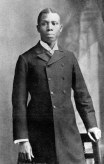|
|
 |
 |
|
Reading Guide |
| 3. |
Self-Image
| - | "Race Love," A. M. E. Church Review, editorial, April 1886 |
| - | Paul Laurence Dunbar, four poems, 1890s |
|
|
 |
"Self-esteem" is a catchword in our times, implying the luxury of self-absorption and the shirking of group attachment. Here we must turn back our perspective, however, and view self-esteem in the context of a people emerging from enslavement, where legally they were not persons and theologically, to some, they had no souls. In the first piece, from the official organ of the African Methodist Episcopal Church (one of the first independent African American denominations), we follow a step-by-step argument for blacks adopting a "self first" philosophy in order to create a viable future. This editorial is paired with four poems by Paul Laurence Dunbar, called the "poet laureate of the Negro race" by the black leader Mary Church Terrell, and one of the few postbellum black poets to be widely read by a white audience. Born in 1872 in Ohio to parents who had been enslaved, Dunbar was a gifted writer whose poems appeared in national periodicals before he was 25 years old. White readers read his dialect poems as entertainment, but Dunbar explored black identity in both his dialect and classical poems. Worthwhile to compare with Du Bois. 6 pages.
Discussion questions
- Why is "race love" the first step to black progress, according to the A. M. E. Church Review? Why is its lack "at the bottom of not a few of our troubles"?
- Of what significance is the fact that this message comes from a religious institution?
- What obstacles to identity and self-respect do African Americans face in postbellum America that other ethnic groups do not encounter? Why is this so?
- In "Ode to Ethiopia," what gives African Americans the "right to noble pride"? How does Dunbar use Christian and mythological references to underscore his point?
- What challenge does Dunbar present to white people in "The Colored Soldiers"?
- To whom does Dunbar address "We Wear the Mask"? Is his tone one of shame or pride, defeat or triumph? an ambiguous in-between? Where lies his self-respect?
- How does Dunbar ennoble the banjo in "The Banjo Song," countering the stereotype of the "Negro banjo player" while writing in the white-preferred format of a dialect poem?
- How do these works reflect the burden of "double consciousness" articulated by Du Bois? How does each author perceive "the Veil"? Can one throw off the Veil?
- On what cornerstone should African Americans base their self-respect?
|
» Link |
 |
 |
Topic Framing Questions
| • |
How did African Americans create personal and group identity after emancipation? |
| • |
How did the challenge differ for those who were previously enslaved and those who were not? |
| • |
How is Christianity central to African Americans' search for identity in this period? |
| • |
How does a culturally disenfranchised group create a "usable past" that guards truth yet nourishes the future?
|
|
|
 |
 |
|
 |
